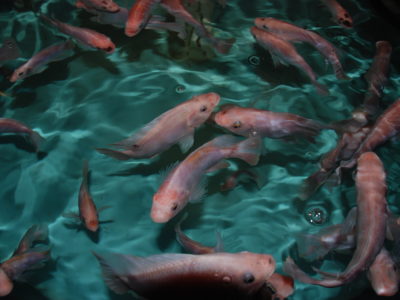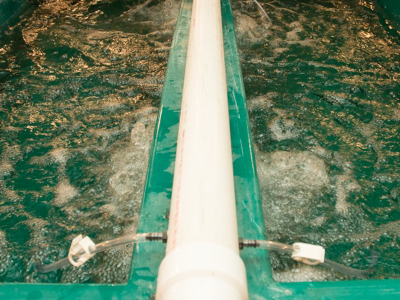Aquaculture 101: What Every Producer Needs to Know
01-06-2015 in Aquaculture
Feel like the waters for aquaculture farming in Iowa are uncharted? Iowa State University Extension aquaculture experts offer a wealth of tips to help you get your aquaculture business off to a good start.
“There are some standard operating procedures (SOPs) to follow to help your operation succeed,” said Allen Pattillo, an Iowa State University Extension aquaculture specialist who spoke at the 2014 Iowa Aquaculture Conference in Ames. “Fish husbandry is all about reducing stress to maximize growth rates.”
These key aquaculture SOPs include:
- Managing water quality. It’s vital to test the water supply before setting up an aquaculture system, said Pattillo, who noted that well water can be a good option. Chlorine is toxic to fish, he added. Once the system is up and running, it’s important to observe the fish daily and check equipment for leaks, in addition to testing the water daily for dissolved oxygen levels, temperature, pH and ammonia levels. “These factors can change quickly and impact the health and growth of your fish,” said Pattillo, who also recommends weekly testing for nitrate and nitrite levels, alkalinity and carbon dioxide.
- Proper feeding. Fresh feed is a key to fish development. Feed also comprises more than 50 percent of the cost of production in an aquaculture operation. Since moldy feeds can contain mycotoxins that affect fish health and growth, check and clean automatic feeders often. While fishmeal has long been a major component of aquaculture feed, global fishmeal supplies are declining, said Steve Hart, executive director of the Soy Aquaculture Alliance. Soy offers a new opportunity, he added. “The nutritional qualities of soymeal and soy protein concentrate make them viable options for fish rations.”
- Monitoring fish health. Since it can be challenging to treat sick fish, disease prevention is best. Acclimate fish gradually to their environment by preventing sudden changes in temperature and pH, Pattillo said. Also, avoid sharp edges on equipment that could injure the fish and create an entry point for infection.
- Effluent management. Solids must be removed quickly for optimal water quality. Effluent management for aquaculture is regulated by the Iowa Department of Natural Resources much like other livestock feeding operations. Producers are encouraged to work with the Coalition to Support Iowa’s Farmers (CSIF) before they start an aquaculture operation to learn more about these regulations.
- Maintaining infrastructure. Always have a backup pump/aeration system in place, along with an electrical generator. Also, have a gravity-fed emergency water supply that contains enough water to perform one full water exchange, Pattillo said.
- Employee management. Train employees in their daily tasks, biosecurity practices and critical tasks for emergencies. Also, have employees regularly record their observations in the aquaculture operation and report back to you or a supervisor, Pattillo said.
While there can be a steep learning curve with aquaculture production, keep an open mind, said Mark Nelson, who runs Iowa’s First aquaculture operation near Blairsburg and Webster City. “I’ve been doing this three years, and I continue to learn something new every day.”
To learn more about practical aquaculture production strategies, tips from growers and more, watch videos from the 2014 Iowa Aquaculture Conference at www.supportfarmers.com/aquaculture.
About the Coalition to Support Iowa’s Farmers
The Coalition to Support Iowa’s Farmers has helped more than 2,800 livestock and poultry farm families over the past 10 years successfully and responsibly grow their farms. CSIF helps families interpret rules and regulations, site new livestock and poultry barns, enhance relationships with neighbors, and implement best management practices for livestock and poultry farmers across the state of Iowa at no charge. For more information, call 800-932-2436 or visit www.supportfarmers.com.
Recommended News

How Aquaculture Growth in Iowa Supports Economy, Creates New Jobs for Farmers
Iowa is one of the many states benefiting from its growing aquaculture industry. According to the Iowa Department of Agriculture, aquaculture generated more than $3.8 million in sales in Iowa...
Read More
CSIF Event Showcases Iowa’s Emerging Aquaculture Industry
The 2022 Aquaculture Conference, hosted by the Coalition to Support Iowa’s Farmers (CSIF), recently drew more than 100 attendees to learn more about Iowa’s newest livestock industry.
Read More
Leading by example
WEST DES MOINES, IOWA – September 19, 2019 – Livestock production is important to Iowa’s economy, contributing $48.5 billion to the state annually, up more than $17 billion from the...
Read More